What Is Ballistic Stretching? Should You Do It Before Exercise?
Get your muscles ready for a workout by performing these warm-up stretches.
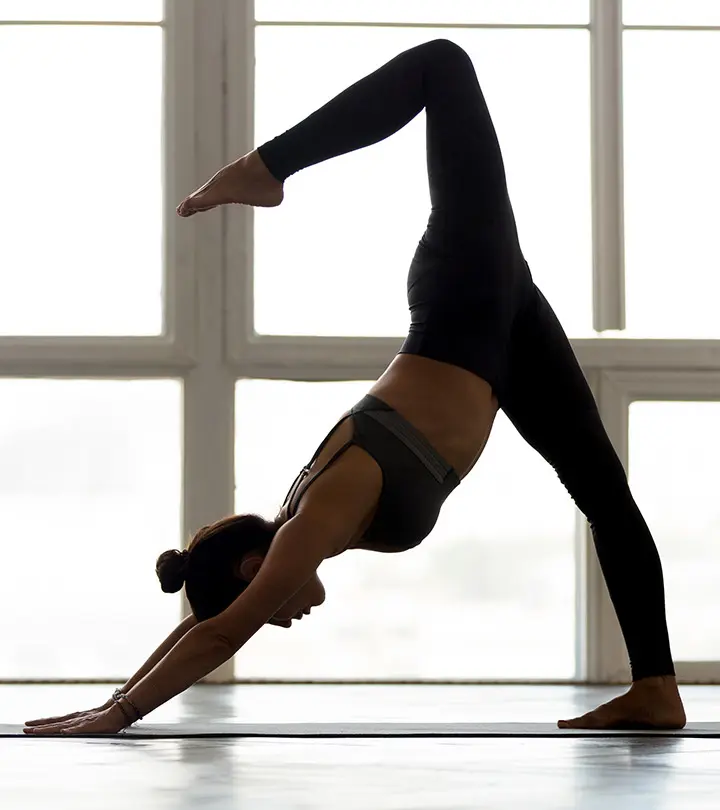
Image: Shutterstock
Ballistic stretching exercise is a warm-up stretch that preps your muscles for a workout. These also include flexibility exercises and active stretching. Stretches with fast and sudden movements help improve flexibility. Dancers and athletes mainly use ballistic stretches to increase range of motion and muscle power (1).

A survey was conducted to investigate the prevalence of stretching practices from various sports or physical activity programs. A total of 3546 questionnaires were analyzed, out of which 47.3% were filled by women and 52.7% were filled by men. 59.6% of respondents believed that stretching exercises were necessary for muscle pain, 59.0% for muscle stiffness, and 60.0% for overall wellness.
However, ballistic stretching is not safe for everyone. Most people should stick to tried-and-true warm-up methods. Continue reading to know all about the ballistic stretch exercise, if it is the best form of warm-up, and its safety concerns.
 Workout Blueprint: Ballistic Stretching
Workout Blueprint: Ballistic Stretching- Frequency: Daily
- Benefits: Improves range of motion, muscle power and stretch, and flexibility.
- Equipment Needed: Exercise mat
- Space Required: Small area
- Assistance Required: Yes, if you are a beginner.
- Who Should Avoid: Anyone who is not a dancer or athlete.
In This Article
What Is Ballistic Stretching?

There are numerous benefits of stretching, including improved flexibility and increased jump momentum. However, Ballistic stretching is a little more profound and specific. Ballistic stretching is extending or forcing a part (or parts) of your body beyond its (their) range of motion. It is done by bouncing and using the momentum to do a hyperextended stretch.
Ballerinas, basketball players, and other athletes perform various ballistic stretching and other sports-specific stretching to improve flexibility and increase jump momentum.
Let’s check out the different kinds of ballistic stretches below.
Key Takeaways
- Ballistic stretching can increase the range of motion, promote flexibility, and prepare your body for exercise.
- Perform this stretching with caution because it might lead to muscle pulls and strains if not done appropriately.
- It is not for individuals with joint issues or anyone with cold muscles.
- In contrast to other stretching techniques, such as static stretching, ballistic stretching is more vigorous and active.
Examples Of Ballistic Stretches
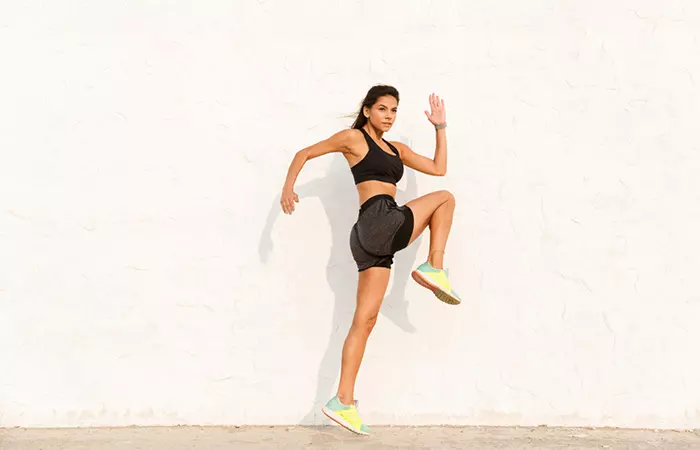
Ballistic stretches are dynamic and involve rapid, bouncing movements. Below are some examples:
- Leg Swings: Stand beside support, swing one leg forward and backward, increasing the height with each swing. This exercise strengthens the hip flexors and prepares the legs for dynamic actions.
- Arm Swings: Open your arms wide and then cross them in front of your chest in a continuous motion. This exercise increases blood flow to the upper body and improves shoulder mobility.
- Torso Twists: Stand with your feet shoulder-width apart and twist your upper body from side to side as if you are trying to look behind you. This exercise increases waist and spine mobility while also improving core flexibility.
- Jumping Jacks: Perform jumping jacks, but in an upward motion, reach out with one arm to the opposite foot. This workout increases heart rate and improves cardiovascular and coordination fitness.
- High Knees: March in place while lifting your knees as high as possible with a rapid bouncing motion. This exercise improves mobility in the lower body and engages the core for improved stability.
Note:
Ballistic stretches may lead to muscle strain, ligament injuries, and decreased flexibility when not done correctly. Static and dynamic stretching are generally safer alternatives.
Studies have found some red flags associated with ballistic stretching. Scroll down to know more about them.
What Are The Dangers Of Ballistic Stretching?

Ballistic stretching may be useful for athletes and dancers. But it can be dangerous for an average person looking to just warm-up before exercise as it involves high-velocity stretching.
Several studies show that ballistic stretches cause hamstring weakness and muscle injuries. A long duration of ballistic stretching may cause hamstringi One of the three posterior thigh muscles located between the hip and the knee to assist in their movement. to quadricepsi Four parts of the large extensor thigh muscles required to perform physical movements like stretching, running, walking, and climbing. imbalance (2).
A study states that static stretching is more useful in increasing hamstring flexibility than ballistic stretching (3). Another study shows that static stretching delays the onset of muscle soreness post-exercise compared to ballistic stretching (4).
It is probably because the muscle sensors pull back when the muscles are stretched beyond their normal range of motion. The sensors do so to prevent muscle injuries due to excessive tension.
While ballistic stretching carries certain dangers, it can be highly effective for improving flexibility and performance when used appropriately. Scroll down to know more.
Benefits Of Ballistic Stretching
Ballistic stretching offers several advantages when performed correctly. Here is the list of benefits:
- Improves Flexibility: Ballistic stretching pushes muscles through a variety of actions, which increases flexibility (1). Therefore, a brief warm-up of ballistic stretches is very helpful for physically demanding activities, especially for athletes participating in sports like gymnastics, basketball, volleyball, soccer, and martial arts, which require ever-higher levels of flexibility.
- Enhances Joint Mobility: Stretching is a powerful way to enhance joint mobility by engaging in a variety of movements (5). Therefore, a well-executed ballistic stretching session may prepare your muscles for intense activity, making it an exciting addition to your exercise routine.
- Promotes Better Circulation: According to research, stretching exercises warm the body and speed up blood flow throughout it (6). The body receives more oxygen, which also speeds up tissue mending.
Besides all the benefits, ballistic stretching is dangerous for non-athletes. It may cause injuries, muscle weakness, muscle sores, and tendon tears. Instead, you may perform static stretching to warm up your muscles before exercising. Here is why static stretches and ballistic stretches are different:
Difference Between Ballistic And Static Stretching
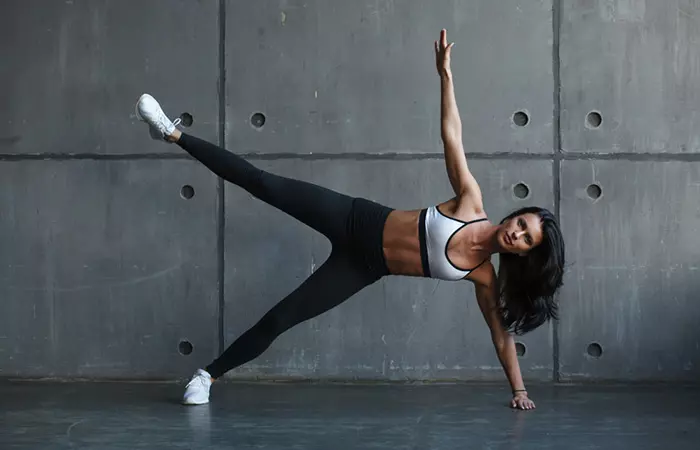
Ballistic stretching is dynamic stretching and involves a sudden bouncing movement. It hyper stretches the target muscle and may lead to injuries. That is why it is no longer recommended for non-athletes.
Static stretching does not involve bouncing or jerky movements like ballistic stretching. It also does not force the movement beyond the range of motion. It helps lengthen the muscle and improves flexibility over a period. It also includes relaxing stretching routines and use of various stretching techniques.
However, if you are an athlete and opting for ballistic stretching, it is important to take safety precautions to reduce the risks connected with ballistic motions. Scroll down to know more.
Safety Guidelines For Ballistic Stretching
Given the risks involved in ballistic stretching, sticking to certain safety precautions to reduce risk and optimize benefits is important. Here are some important points to remember:
- Warm up your muscles thoroughly before doing ballistic stretches to improve blood flow and prepare them for dynamic movements.
- Do stretches gradually, avoiding abrupt or forceful motions at first to give your muscles time to adjust.
- Recognize the limits of your body and refrain from extending your muscles’ range of motion.
- When performing stretches, use the proper form to avoid putting excessive stress on your muscles and joints.
- Consult a trainer or physical therapist to help you safely complete the exercise if you are new to ballistic stretching or are unsure of your technique. It will help you avoid injuries.
While safety precautions can make ballistic stretching safer, there are alternative warm-up stretches that can be used to prepare the muscles. Scroll down to learn more about them.
Alternative Safe Warm-Up Stretches

Here are the stretches you can do before working out:
- Arm circles
- Neck tilts
- Neck rotations
- Shoulder rotations
- Side lunges
- Toe touches
- Downward dog pose
- Calf stretches
- Yoga stretches
 Quick Tip
Quick TipDoing static stretching to warm up your muscles before doing jumping exercises or any basic exercise is better. But you may do ballistic stretching if you fall under the categories discussed in the next section.
Who May Do Ballistic Stretching
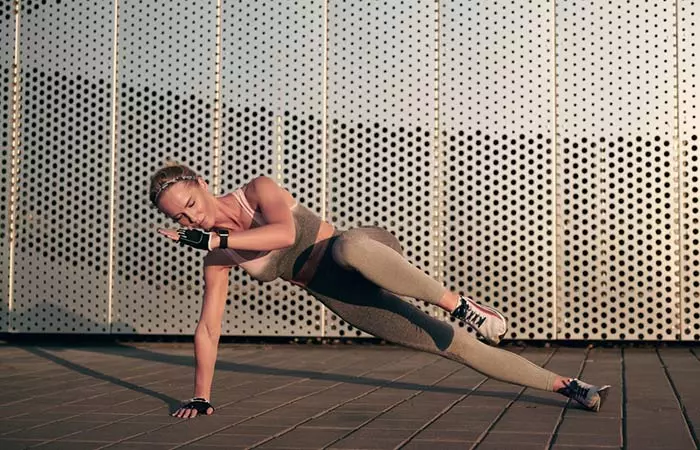
You may do ballistic stretching if:
- Your doctor or trainer has approved it.
- You are an athlete.
- You are a ballet dancer.
 Quick Tip
Quick TipInfographic: Dangers Of Ballistic Stretching And Safer Alternatives
You need to understand the potential dangers associated with certain stretching techniques to properly improve your flexibility and fitness. Some stretching techniques can cause muscle strain, joint pain, and even serious injuries if not done the right way. Hence, it is important to ensure safe and effective stretching practices. The infographic below sheds light on the dangers of ballistic stretching and provides safer alternatives. Check it out!
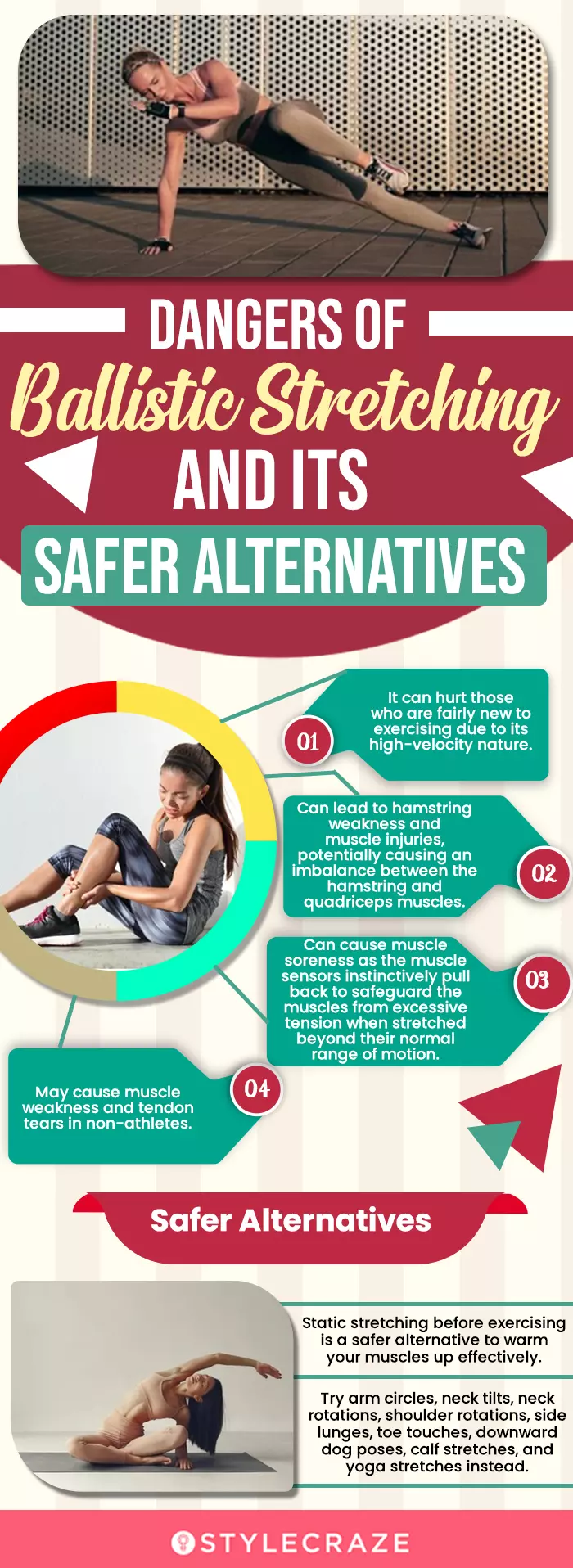
Illustration: StyleCraze Design Team
Maintaining a healthy and fit body requires regular workouts. A good muscle warm-up stretch prepares your body for strenuous exercising. If you do not do them, you may suffer an injury or increased muscle soreness. Ballistic stretching exercises are common warm-up exercises for professional dancers and athletes. Other various practices that are common amongst athletes are stretching drills, sports stretching, functional training, and speed training. However, they are not recommended for everyone as they may lead to tendon tears and muscle injuries. These vigorous ballistic stretches include proper movement preparation like moving your limbs and core beyond the normal range of motion, which can be risky if not done properly. Make sure you are doing the exercise correctly and under the guidance of a professional to prevent the risk of injuries.
Frequently Asked Questions
What is an example of a ballistic stretch?
A simple example of ballistic stretch is rolling down and bouncing up and down, trying to touch your toe.
Is dynamic stretching the same as ballistic stretching?
Ballistic stretching is a type of dynamic stretching. It is risky and may cause injuries. It should only be practiced by athletes and ballet dancers.
Which type of stretching has the highest risk of injury?
Ballistic stretching has the highest risk of injury in an average person. It may cause muscle weakness and soreness.
Why should you not bounce when stretching?
Bouncing stretches the muscles beyond their normal range of motion. Doing this regularly can lead to muscle weakness.
Is high knees a ballistic stretch?
No, high knees are a type of dynamic stretching exercise that helps open up the lower body. Unlike ballistic stretching, there is no bouncing or momentum involved in dynamic stretching and the muscles are not stretched beyond their normal range of motion.
What ballistic skills can improve your body?
Upward lunges, shoulder rotations, arm, leg, chest swinging exercises, and other various mobility exercises and agility exercises help improve blood circulation and flexibility.
Is kicking a ballistic movement?
Yes, kicking, throwing, striking, and swinging are all types of ballistic movement. Ballistic stretching can aid athletes in broadening their range of motion. These ballistic movements can help an athlete kick harder or jump higher.
References
Articles on StyleCraze are backed by verified information from peer-reviewed and academic research papers, reputed organizations, research institutions, and medical associations to ensure accuracy and relevance. Read our editorial policy to learn more.
- Woolstenhulme, Mandy T et al. “Ballistic stretching increases flexibility and acute vertical jump height when combined with basketball activity.” Journal of strength and conditioning research vol. 20,4 (2006): 799-803.
https://pubmed.ncbi.nlm.nih.gov/17194248// - Lima, Camila D et al. “Effects of Static Versus Ballistic Stretching on Hamstring:Quadriceps Strength Ratio and Jump Performance in Ballet Dancers and Resistance Trained Women.” Journal of dance medicine & science : official publication of the International Association for Dance Medicine & Science vol. 22,3 (2018): 160-167.
https://pubmed.ncbi.nlm.nih.gov/30139422// - Covert, Christopher A et al. “Comparison of ballistic and static stretching on hamstring muscle length using an equal stretching dose.” Journal of strength and conditioning research vol. 24,11 (2010): 3008-14.
https://pubmed.ncbi.nlm.nih.gov/20375742// - Smith, L L et al. “The effects of static and ballistic stretching on delayed onset muscle soreness and creatine kinase.” Research quarterly for exercise and sport vol. 64,1 (1993): 103-7.
https://pubmed.ncbi.nlm.nih.gov/8451526// - Harvey, Lisa et al. “Does stretching induce lasting increases in joint ROM? A systematic review.” Physiotherapy research international : the journal for researchers and clinicians in physical therapy vol. 7,1 (2002): 1-13. doi:10.1002/pri.236
https://pubmed.ncbi.nlm.nih.gov/11992980/ - Kato, Michitaka, et al. “The efficacy of stretching exercises on arterial stiffness in middle-aged and older adults: a meta-analysis of randomized and non-randomized controlled trials.” International journal of environmental research and public health 17.16 (2025): 5643.
https://www.researchgate.net/publication/343468299_The_Efficacy_of_Stretching_Exercises_on_Arterial_Stiffness_in_Middle-Aged_and_Older_Adults_A_Meta-Analysis_of_Randomized_and_Non-Randomized_Controlled_Trials
Read full bio of David Rosales
Read full bio of Ravi Teja Tadimalla
Read full bio of Himanshi Mahajan






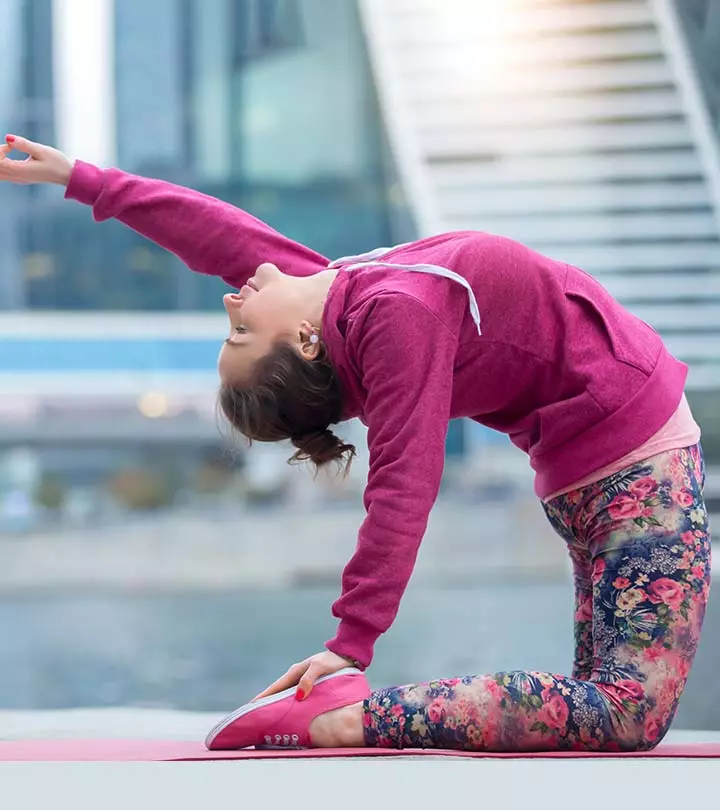
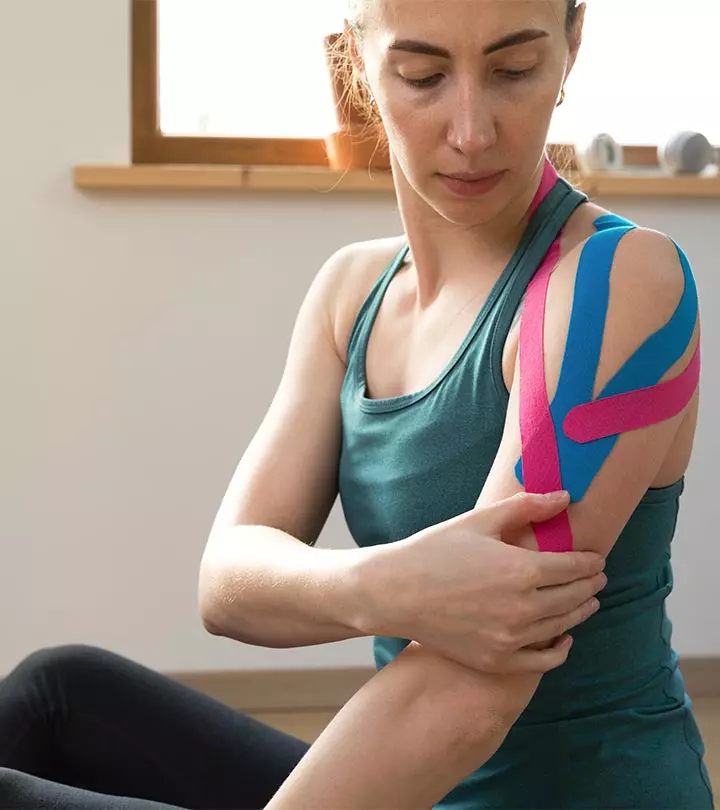











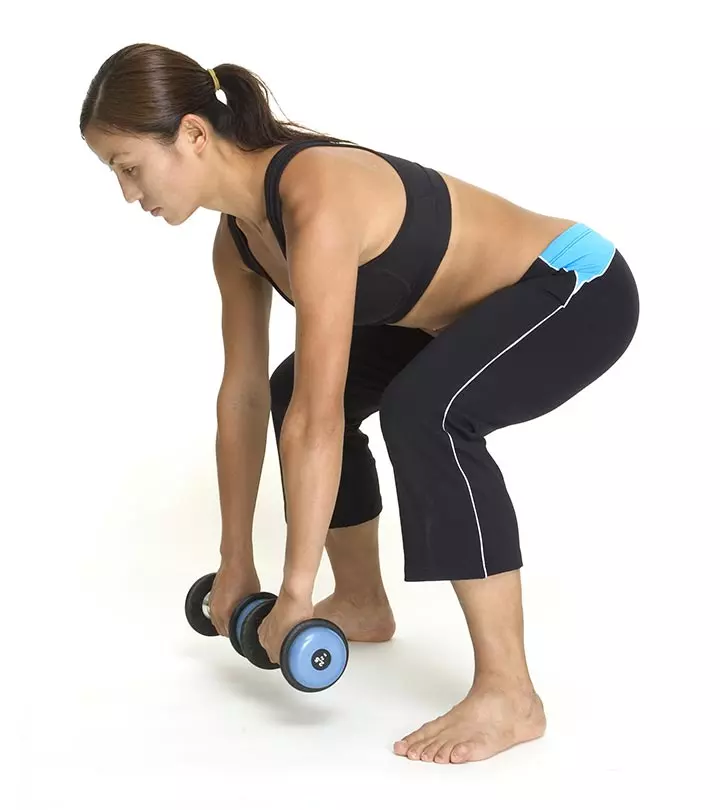

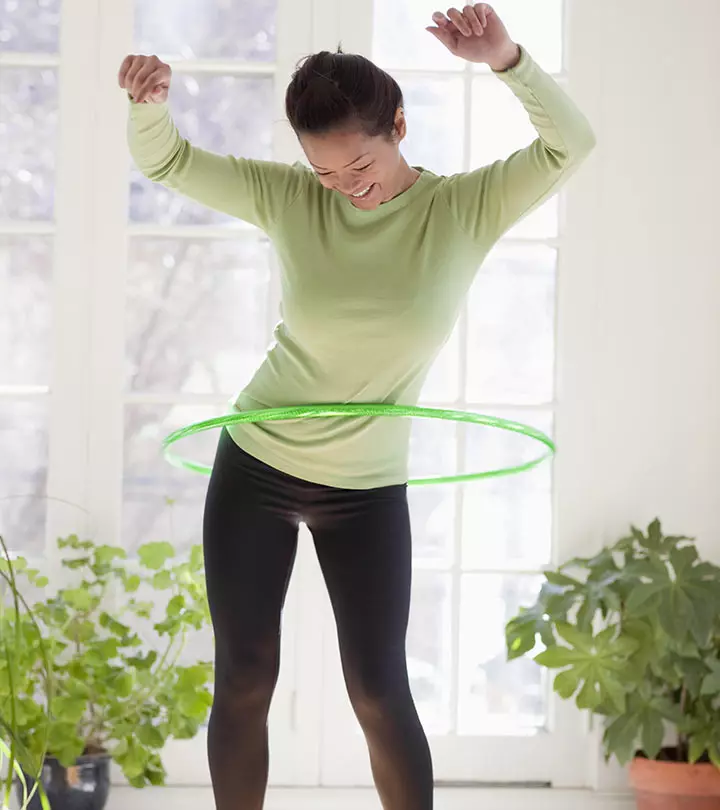
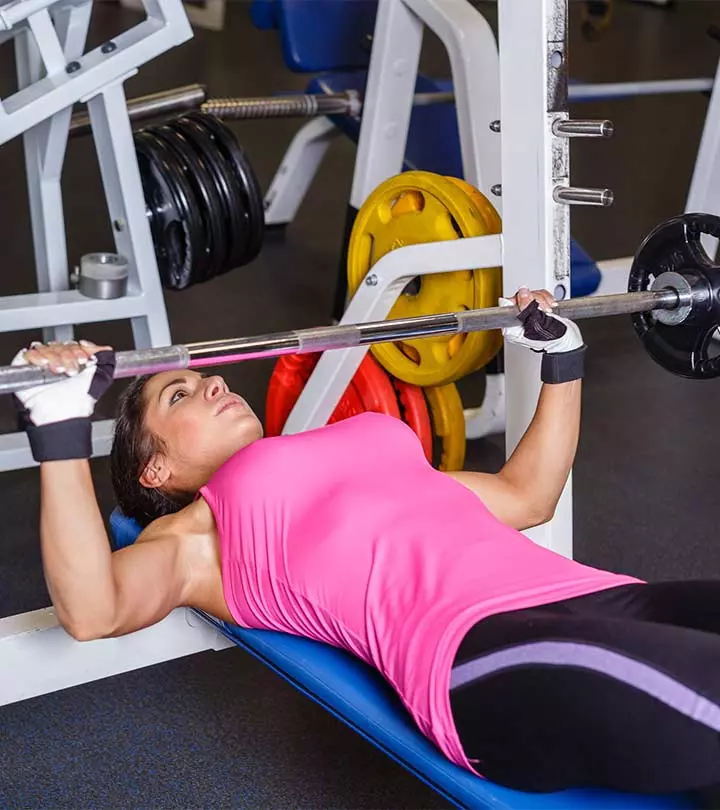
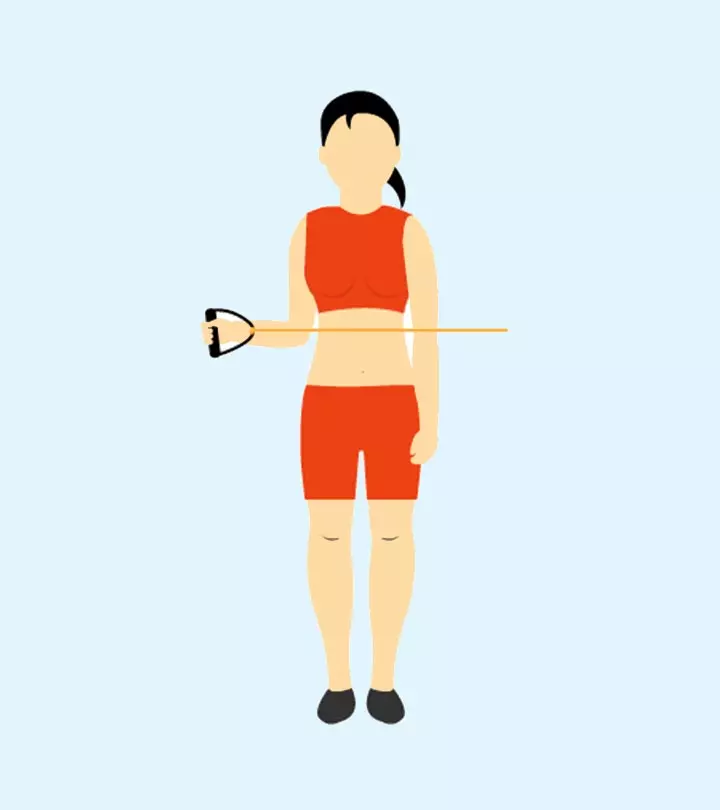

Community Experiences
Join the conversation and become a part of our empowering community! Share your stories, experiences, and insights to connect with other beauty, lifestyle, and health enthusiasts.